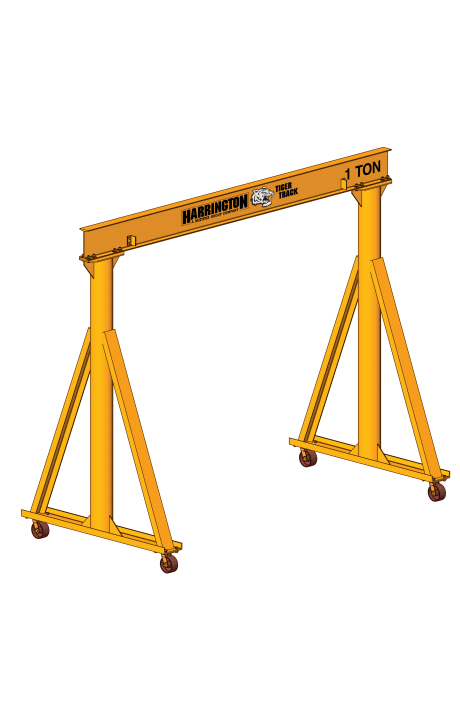Featured Brands
BRIDGE CRANES
Bridge cranes, also known as overhead cranes, play a crucial role in modern material handling and construction industries. These versatile lifting machines are designed to move heavy loads horizontally along the bridge structure, making them indispensable for various applications.
Single Girder Bridge Crane
The single girder bridge crane is a popular and cost-effective option for light to medium-duty lifting tasks. It features a single horizontal girder supported by end trucks that travel on a runway beam. Ideal for smaller workshops and warehouses, this crane offers ease of installation and maintenance, making it a practical choice for businesses with limited space and budgets.
FEATURES:
Cost-effective and budget-friendly option.
Versatile for diverse lifting applications.
Easy installation and low maintenance.
Underhung Bridge Crane
Underhung bridge cranes are designed to maximize available floor space while providing efficient material handling solutions. The crane's end trucks run on the lower flange of the runway beam, allowing it to be installed within the building's roof structure. Underhung bridge cranes are commonly used in workshops and manufacturing facilities with limited headroom.
FEATURES:
Space-saving design for limited headroom.
Suitable for low to medium-duty lifting.
Smooth and precise material handling.
Gantry CraneS
Gantry cranes are similar to bridge cranes but differ in their supporting structure. Instead of being fixed to an elevated runway, gantry cranes are supported by legs or wheels that move on the ground. This mobility allows for more flexibility and versatility, making gantry cranes ideal for outdoor applications, loading docks, and construction sites where the runway cannot be installed.
FEATURES:
Versatile and movable lifting solution.
Ideal for outdoor and indoor use.
Offers high load capacity and stability.
Monorail/Workstation CraneS
Monorail cranes comprise a single girder system that runs along a fixed track or beam. They are best suited for moving loads along a linear path within a facility. Monorail cranes are often used in assembly lines, warehouses, and areas where repetitive material handling tasks are prevalent.
FEATURES:
Designed for efficient workstation lifting.
Ideal for moving materials along a fixed path.
Compact and flexible, suitable for limited spaces.
About Overhead Cranes
What Type of Crane is Right for Your Application?
While our team can assist you with determining the proper application, CMAA (Crane Manufacturers Association of America) has established crane service classification is based on the load spectrum reflecting the actual service conditions as closely as possible. The CMAA Crane Service Classes are as follows:
CLASS A (STANDBY OR INFREQUENT SERVICE)
This service class covers cranes which may be used in installations such as power houses, public utilities, turbine rooms, motor rooms and transformer stations where precise handling of equipment at slow speeds with long, idle periods between lifts are required. Capacity loads may be handled for initial installation of equipment and for infrequent maintenance.
CLASS B (LIGHT SERVICE)
This service covers cranes which may be used in repair shops, light assembly operations, service buildings, light warehousing, etc. where service requirements are light and the speed is slow. Loads may vary from no load to occasional full rated loads with two to five lifts per hour, averaging ten feet per lift.
CLASS C (MODERATE SERVICE)
This service covers cranes which may be used in machine shops or paper mill machine rooms, etc., where service requirements are moderate. In this type of service the crane will handle loads which average 50 percent of the rated capacity with 5 to 10 lifts per hour, averaging 15 feet, not over 50 percent of the lift at rated capacity.
CLASS D (HEAVY SERVICE)
This service covers cranes which may be used in heavy machine shops, foundries, fabricating plants, steel warehouses, container yards, lumber mills, etc., and standard duty bucket and magnet operations where heavy duty production is required. In this type of service, loads approaching 50 percent of the rated capacity will be handled constantly during the working period. High speeds are desirable for this type of service with 10 to 20 lifts per hour averaging 15 feet, not over 65 percent of the lifts at rated capacity.
For our team to best assist you, they will be asking for details that aren’t always so obvious. The following questions can help with the consultation process.
Will the crane be installed indoors or outdoors?
What is the application the crane be used for?
Will the crane be exposed to extreme conditions (chemical or high heat)?
Total number of cranes needing to be installed
Crane capacity
What is the total lift height required?
Span of crane and length of the runway?
Will this be a new or existing runway and support structures?
What power supply (480V, 230V, etc.)
Any obstacles that could hinder the proper operation of the crane?
What is your installation timeline?










